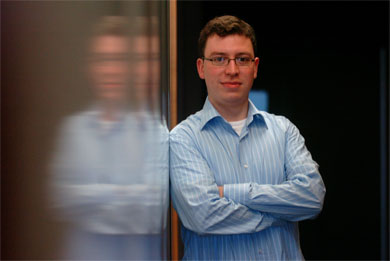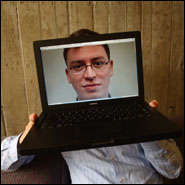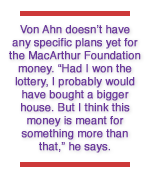|
|
|||||
|
|
Brilliant Young Scientist Luis von Ahn Earns $500,000 MacArthur Foundation "Genius Grant"
At age 27, Luis von Ahn is this year's youngest MacArthur fellow.
Luis von Ahn thinks big. And he's trying to think much bigger.
Thinking big already has led von Ahn, an assistant professor of computer science, to invent Internet games that harness the brainpower of thousands of people to accomplish useful tasks beyond the ken of any digital computer.
Von Ahn's ambition to further stretch this technique, called "human computation," got an unexpected boost last week when he received a call from the John D. and Catherine T. MacArthur Foundation, notifying him that he is one of 25 new MacArthur fellows for 2006.
As a recipient of the celebrated MacArthur Foundation "genius grant," von Ahn will receive $500,000 in "no strings attached" support for the next five years. In addition to his work on human computation, the foundation cited him for his role in developing the CAPTCHA tests to help Internet sites distinguish between human users and computers and for developing a series of protocols in the subdiscipline of cryptography known as steganography.
The award comes on the heels of Popular Science naming him as one of its "Brilliant 10," the magazine's annual listing of young scientists "who are changing not just what we know, but the limits of what we know."
Von Ahn doesn't have any specific plans yet for the MacArthur Foundation money. "Had I won the lottery, I probably would have bought a bigger house. But I think this money is meant for something more than that," he says.
"I want to have a site where literally millions of people come and work on tasks that are useful for humanity," he says.
The idea to use the Internet to create a network of human computers germinated while von Ahn, a native of Guatemala, was a Carnegie Mellon graduate student working with University Professor of Computer Science Manuel Blum. As he and Blum saw it, people were wasting millions of hours online playing games such as solitaire; they figured that if they could devise a sufficiently interesting game, they could steal those brain "cycles" to do real work.
The first game von Ahn created was the ESP Game, which paired up players who typed words to describe an inadequately captioned photo from the Web, attempting to match each other. Matches earned the players points — and generated keywords that could be used to aid image searches. The game was and remains popular, with more than 75,000 players to date and some playing for 20 hours or more.
Then came Peekaboom, a multi-player game that generated annotated images used to train computer vision systems. Final touches are now being put on a new game called Phetch, which generates descriptions of images that can be used to make the Web more accessible to blind people.
"A lot of people think it's a good idea," he says. "The problem is, coming up with a well-done game is a hard task." It's not just getting the game working right, he emphasized, but making a game that's fun to play.
Eventually, however, von Ahn wants to take fuller advantage of the Internet to harness people's minds. The Panama Canal was built with tens of thousands of workers, the Apollo program took 50,000, the pyramids perhaps 100,000, he notes. "Now, we can get 400 million people working together."
But what would 400 million people do? What would be the Internet equivalent of a moon shot? "We just can't think big enough," he says. "I don't think I can think big enough yet."
Other 2006 MacArthur fellows include: naturalist author/illustrator David Carroll of Warner, N.H.; jazz violinist Regina Carter of New York City; comparative neurobiologist Kenneth Catania of Vanderbilt University; tropical forester Lisa Curran of Yale University; developmental biologist Kevin Eggan of Harvard University; technologist James Fruchterman of Palo Alto, Calif.; surgeon/author Atul Gawande of Harvard Medical School; bioengineer Linda Griffith of MIT; pharmaceutical entrepreneur Victoria Hale of San Francisco; and narrative journalist Adrian LeBlanc of New York City.
Others are author/illustrator David Macaulay of Norwich, Vt.; sculptor Josiah McElheny of New York City; country doctor/researcher D. Holmes Morton of Strasburg, Pa.; physician John A. Rich of Drexel University; social psychologist Jennifer Richeson of Northwestern University; playwright Sarah Ruhl of New York City; short story writer George Saunders of Syracuse University; artist Anna Schuleit of New York City; painter Shahzia Sikander of New York City; mathematician Terence Tao of UCLA; aviation engineer Claire Tomlin of Stanford University; deep-sea explorer Edith Widder of Ft. Pierce, Fla.; cosmologist Matias Zaldarriaga of Harvard University and composer John Zorn of New York City.
Hundreds of anonymous nominators help the foundation identify potential fellows each year. A 12-member selection committee, also anonymous, makes final recommendations for fellows to the foundation's board of directors.
Byron Spice |
|||
|
Carnegie Mellon Home |
|||||


 Von Ahn, who earned his master's (2003) and doctorate (2005) degrees in computer science at Carnegie Mellon before joining the Computer Science Department faculty this summer, has plans for at least five more games. And the idea is catching on elsewhere, with researchers at major universities and some private companies working on their own "games with a purpose."
Von Ahn, who earned his master's (2003) and doctorate (2005) degrees in computer science at Carnegie Mellon before joining the Computer Science Department faculty this summer, has plans for at least five more games. And the idea is catching on elsewhere, with researchers at major universities and some private companies working on their own "games with a purpose."